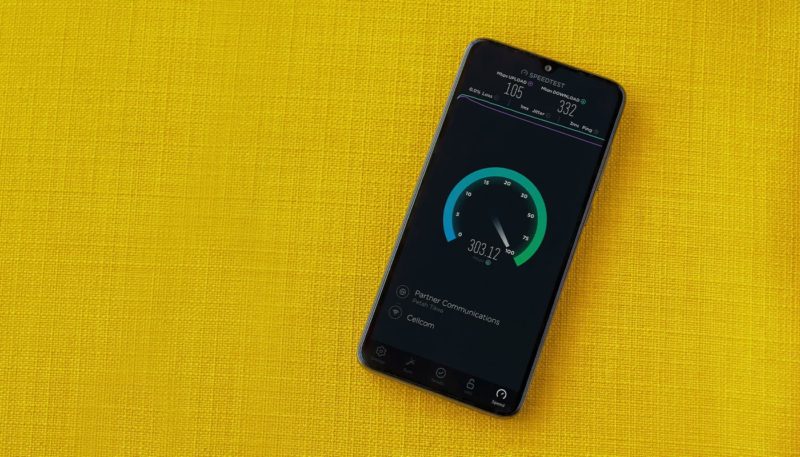Broadband comes in many shapes and sizes. From the provider and package chosen to the router’s ability to spread Wi-fi around your home, your broadband speed will vary.
Whether you have or are looking for a great broadband deal or want to learn more about broadband speeds, we’ve written this article to help you. Our team at Giganet have given us their first-hand experience when it comes to broadband speeds. We’ll cover everything you need to know about broadband speed and how you can get the best speeds when choosing your next broadband package.

Ookla broadband speed test results
How are broadband speeds measured?
Broadband and Wi-Fi speeds are measured in megabits per second, also known as Mbps or Mb/s. Bits are tiny units of data, with a megabit representing a million of them. The higher the number of Mbps, the faster your download and upload speed should be.
So, does that mean a download speed of 100 Mbps can download a 100MB (Megabyte) file in one second? Unfortunately, not. A megabit represents one-eighth the size of a Megabyte, this means that to download a 100MB file in one second, you’d need a connection speed of 800Mbps.
Thanks to advances in broadband technology, we’re now in an age of hyperfast and gigabit-capable broadband. This is where you can unlock speeds of 1 Gigabit per second (Gbps) or 1,000 Mbps.
Download speeds vs upload speeds
We’ve all experienced that feeling when downloading a file or streaming a video seems to take forever. You might also be familiar with a lengthy wait for videos to upload while you back up files to the cloud. It’s all because different tasks require different types of internet speed.
Specifically, internet speed is divided into two main categories: Download speeds and Upload speeds. Understanding the difference between these two speeds can help you optimise and improve your overall online experience. Put simply, a faster upload or download speed means you can do these things more quickly and efficiently.
- Download Speeds – these refer to how quickly data can be transferred from the internet to your computer or device. This is the speed at which you can download files, stream videos, or load website pages.
- Upload Speeds – these refer to how quickly you can transfer data from your computer or smart device to the internet. This is the speed at which you can upload files, send emails with attachments, or post pictures and videos online.
What is a good broadband speed?
Naturally, we get asked this a lot at Giganet. With the demand for faster broadband and average household bandwidth requirements increasing year on year, the broadband speed you need is forever growing. This constant evolution is partly down to how much more bandwidth we need for the things we like to do on the internet. Take 4K video for example, 4K video needs higher download speeds in order to watch it without regular buffering. This means your broadband speed needs to be at least 50Mb/s to stream 4K video from your favourite streaming platform. However, if like most households, you have other devices using your broadband connection at the same time, this is going to reduce how much bandwidth you have to play with for video streaming in 4K.

Best broadband speed for working at home.
If you work from home, your broadband speeds won’t be your only concern. You’ll want a reliable connection as well.
For example, if you make regular video calls, you’ll need to make ensure your connection not only works well, but also doesn’t drop out. We all know the pain when you’re on an important video call and screen freezes. It’s a nightmare!
A characteristic of the copper technologies used to deliver standard broadband is that connection speeds slow down due to signal loss in the copper over which your data travels.
For a dependable modern alternative, full fibre broadband is typically faster and more reliable than standard broadband, making it perfect for larger households that spend a lot of time online.
For remote workers downloading and uploading lots of files, you might want to consider choosing a broadband speed of at least 150Mb/s. Not only will this give you enough bandwidth to send and receive your files quickly, it’ll also mean other members of your household can continue using the broadband connection without slowing anyone else down.
For homes with multiple remote workers and gamers, you might prefer to opt for even faster broadband like a 300Mb/s or 500Mb/s package. Imagine that! Everyone is online at once and no arguments over who’s hogging the bandwidth.

Best broadband speed for gaming
Anyone who plays games knows how important it is for gameplay to run smoothly. So, it’s pretty cruddy when you’re in the middle of an online deathmatch and your broadband connection cuts out or your ping is super high.
Thankfully, with broadband speeds now in the gigabit territory, you won’t face those pesky problems so often. When gaming, our team at Giganet recommend that you choose a broadband speed and connection that provides greater reliability and symmetrical speeds of at least 500Mb/s. This will allow you to game in peace without other members of the household slowing your connection down.
For more heavy usage homes, a full fibre broadband connection with 900Mb/s download and upload speeds should help keep your games running smoothly.

Best broadband speed for streaming video
Streaming video can use a lot of data, especially if you stream in 4K. With many platforms like Netflix now offering 4K streaming as a standard, people are needing faster broadband speeds to keep up with the increased bandwidth usage.
Thankfully, with full fibre broadband becoming widely available across the UK, there are now plenty of options that allow you to enjoy video streaming without interruption. When streaming video, it’s recommended that you have at least 50Mb/s if no one else is using the broadband. If you have other users on your network, then you might want to consider a broadband connection with speeds between 150Mb/s and 900Mb/s. The more users on your network, the more bandwidth you’ll need.
What broadband speed can I get?
It’s always worth shopping around to see what broadband speeds you can get. Many providers offer broadband deals at certain times of the year, and you can often find great broadband packages at fantastic prices. However, it’s worth knowing that modern, full fibre technology is becoming widely available across the UK and you’ll find these speeds are up to 16x faster than standard broadband connections. With a focus on moving more homes and businesses onto these newer networks, full fibre packages can often be found at comparable or even cheaper prices.
As a starter, we recommend you enter your postcode into our broadband availability checker or Ofcom to see what speeds are available for your location. You could be getting much better broadband and be paying less for it too.
Checking your speed
If you’re unsure how fast your current broadband is, you can check your download and upload speeds with an online speed test through trusted websites like Ookla or Which Speed Test.
These speed-checking websites work by measuring your current connection’s maximum speed – how fast your device can upload and download files – by accessing nearby test servers. The speed test mimics your online activity in a controlled setting by downloading sample files and recording speeds. At the end of the test, you are given an average download and upload speed.

Broadband speed test
Getting an accurate speed test result
To conduct an accurate speed test there are a few simple steps you can take
- If possible, connect the device you’re testing to an ethernet cable. Or move as close to the router
- Run an audit to see what devices are currently hooked up to your router and disconnect any you no longer need
- Run the test a few times throughout the day and during different activities. Speed will vary at busy times and will be impacted by other members of your household using the internet
- Shut down any tabs or apps that may be running in the background
- Check nothing’s downloading in the background, like Photoshop or Spotify
Is superfast broadband fast enough?
Superfast broadband is commonly used to advertise a connection which uses fibre up to the cabinet (FTTC) but you’ll find the rest of the connection to your home still utilises old copper cabling. In the last decade, this technology has allowed broadband providers to deliver an improved broadband connection with speeds up to 80Mb/s to large parts of the UK.
However, superfast broadband speeds are quickly becoming outdated with the significant rollout of full fibre broadband in recent years. This new technology is providing homes with speeds up to 900Mb/s and significantly improved reliability.
What about full fibre broadband?
Considering the efficiencies of newer technology, we would always recommend switching to full fibre broadband if it’s available at your address. Full fibre broadband offers a significantly improved level of reliability and speed. It’s also available at a similar price to superfast connections.
Full fibre uses fibre optic cables from the local exchange all the way directly to your home. This removes the need for old copper cabling and brings a future-proofed technology to your household.
Currently, full fibre broadband is available to 42% of households in the UK (October 2022). This is expected to rapidly increase and is expected to reach 60-80% coverage by 2025. So, it’s worth registering your interest with the provider building your new full fibre network, so you’ll be the first to know when a full fibre upgrade becomes available.
Why do broadband speeds vary?
Broadband speeds can vary from household to household, depending on a range of factors. These factors can be caused by a few things and also vary depending on the provider you are using.
- Your address – Where you live, and your address can have a big impact on the type of broadband service your household can receive. If you live in a highly populated town or city, you most certainly have access to high-speed broadband. This could be fibre broadband or full fibre broadband. However, in addition to the general location you live in, an address on the opposite side of your street may have a different broadband provider to you, which isn’t available at your address. It’s always wise to check your address with a variety of broadband providers to find the best speeds and deals.
- Technology – There are a range of broadband technologies available to households in the UK which all offer varied speed offerings. From superfast to ultrafast and full fibre, they all offer widely different download and upload speeds.
- Time of usage – When you use your broadband during peak times, your ISP (Internet Service Provider) may reduce your broadband performance for short periods of time. Peak times are normally evenings and weekends when more people are using the ISPs service. There are many broadband providers that do not limit your bandwidth I including Giganet.
- Service outages – Depending on the type of infrastructure your broadband service uses, your broadband speed could be impacted by various outages or degraded performance from your ISP. This is unfortunately unavoidable for most households. However, choosing full fibre broadband can massively improve performance and reduce the potential for outages or poor performance.
Looking for a broadband provider?
We’ve been impartial up until this point but if you’re looking for a broadband provider, try Giganet! We offer full fibre broadband to homes across the UK. Enjoy speeds up to 900Mb/s at great prices. Giganet is an award-winning broadband provider bringing greater reliability and speed to your home. For more information, visit our broadband page.


